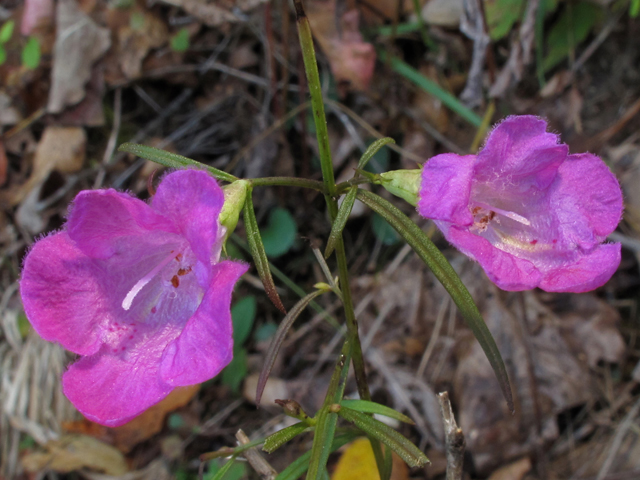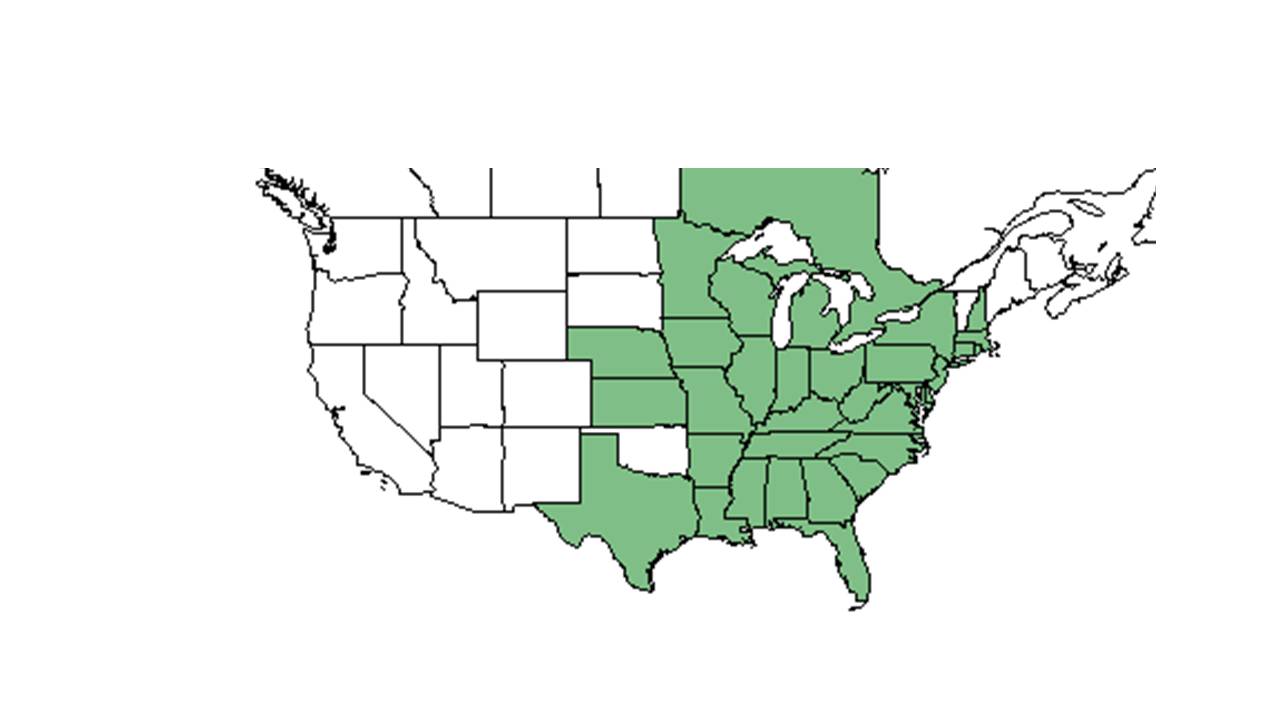Difference between revisions of "Agalinis purpurea"
(→Diseases and parasites) |
(→Pollination and use by animals) |
||
| Line 48: | Line 48: | ||
===Pollination and use by animals=== | ===Pollination and use by animals=== | ||
| − | ''A. purpurea'' is visited by pollinators such as ''Perdita gerardiae'' (family | + | ''A. purpurea'' is visited by pollinators such as ''Perdita gerardiae'' (family Andrenidae) and ''Anthophorula micheneri'' (family Apidae), and is a host to aphids such as ''Aphis nerii'' (family Aphididae).<ref>Discoverlife.org [https://www.discoverlife.org/20/q?search=Bidens+albaDiscoverlife.org|Discoverlife.org]</ref> This species has been observed as hosting other pollinators such as ''Melissodes'' spp. (family ''Apidae'') and ''Megachile'' spp. (family ''Megachilidae'').<ref name="illinois">[[http://www.illinoiswildflowers.info/prairie/plantx/pf_foxglovex.htm]]Illinois Wildflowers. Accessed: March 22, 2016</ref> Caterpillars of the butterfly ''Junonia coenia'' (buckeye) feed on the foliage.<ref name="illinois"/><ref name="Hammer 2016">Observation by Roger Hammer in Silver Springs State Park, Marion County, FL. September 2016, posted to Florida Flora and Ecosystematics Facebook Group August 4, 2017.</ref> |
===Diseases and parasites=== | ===Diseases and parasites=== | ||
Revision as of 13:41, 21 June 2021
| Agalinis purpurea | |
|---|---|

| |
| Photo by Alan Cressler | |
| Scientific classification | |
| Kingdom: | Plantae |
| Division: | Magnoliophyta - Flowering plants |
| Class: | Magnoliopsida - Dicotyledons |
| Order: | Lamiales |
| Family: | Orobanchaceae |
| Genus: | Agalinis |
| Species: | A. purpurea |
| Binomial name | |
| Agalinis purpurea (L.) Pennell | |

| |
| Natural range of Agalinis purpurea from USDA NRCS Plant database. | |
Common names: Smooth gerardia; Purple false foxglove
Contents
Taxonomic notes
Synonyms:Gerardia purpurea var. purpurea; Gerardia purpurea Linnaeus.[1]
Description
Agalinis purpurea is an annual plant that acts as a parasite on the roots of grasses and other herbs. The stems are rough with a fine pubescence, grow up to 4-12cm tall, and are profusely branched on the upper 1/2 - 2/3. The leaves are narrow, linear, oppositely arranged and weakly fascicled (clustered), often curled, and pubescent. The flowers occur on terminal raceme clusters, are rose-lavender or (rarely) white in color, and the corolla petals have yellow lines and purple spots. The flowers have 4 stamens and elongated stigmas. .[2]
Distribution
It is frequent in all of Florida. Found from west to Texas, north to Massachusetts.[3]
Ecology
Habitat
Agalinis purpurea is found in a wide variety of soils in low, wet, sandy or peaty areas such as stream sides and moist depressions within frequently burned pine communities; seepage slopes, fresh water marshes, cypress flats, and hardwood swamps. It also occurs on shallow limerock soils of slash pine rocklands in South Florida, as well as in high, well drained sandhills (Entisols). It occurs primarily in high light conditions, although it can also occur in relatively shaded habitats such as cypress and hardwood swamps.[4] It is tolerant of high densities of grass and sedges such as in pitcher plant bogs and marshes. It is considered an early invader of disturbed soils, yet persists as other species colonize in savannas. [5] It also can be found alongside roads, bordering flatwoods, powerline corridors, and other disturbed areas.[4]
Associated species include those in the following genuses: Pinus, Quercus, Cyrilla, Panicum, Hyptia, Eriocaulon, Aletris, and others.[4]
Phenology
It flowers from April to November, primarily in October, and fruits from May to November.[4] Agalinis purpurea has been observed to flower from August to December in north Florida.[6]
Seed bank and germination
Agalinis purpurea was absent from the seed bank of ephemeral ponds in Hyannis though they were present as adults. The composition of the seed bank often predicts the future composition of plants after the disturbance of water level drawdown.[7]
Fire ecology
Communities are near fire-dependent communities such as longleaf pine/wiregrass communities.[4]
Pollination and use by animals
A. purpurea is visited by pollinators such as Perdita gerardiae (family Andrenidae) and Anthophorula micheneri (family Apidae), and is a host to aphids such as Aphis nerii (family Aphididae).[8] This species has been observed as hosting other pollinators such as Melissodes spp. (family Apidae) and Megachile spp. (family Megachilidae).[9] Caterpillars of the butterfly Junonia coenia (buckeye) feed on the foliage.[9][10]
Diseases and parasites
A. purpurea is a hemiparasitic species capable of extracting sugars and proteins from a host, along with surviving without a host by preforming photosynthesis.[11] In the absence of a host, it grows autotropically and can complete its lifecycle without a host. When a host is present, reception of chemical signals enable the parasitic mode causing root elongation to slow and accelerated growth of haustorium. Haustorium are not present unless a host is present.[12]
Compatible host plants for A. purpurea include Carya illinoinensis[1], Fraxinus pennsylvanica, Nyssa sylvatica[2], Pinus elliottii[3], P. palustris[4], P. strobes, P. taeda[5], Populus deltoides, Quercus alba, Q. shumardii, and Taxodium distichum.[11]
Conservation, cultivation, and restoration
Cultural use
Photo Gallery
References and notes
- ↑ Weakley, A.S. 2015. Flora of the southern and mid-atlantic states. Working Draft of 21 May 2015. University of North Carolina at Chapel Hill, Chapel Hill, North Carolina.
- ↑ Radford, Albert E., Harry E. Ahles, and C. Ritchie Bell. 1964, 1968. Manual of the Vascular Flora of the Carolinas. The University of North Carolina Press. 960 pp. Print.
- ↑ Hall, David W. 1993. Illustrated Plants of Florida and the Coastal Plain: based on the collections of Leland and Lucy Baltzell. A Maupin House Book. Gainesville. 342 pp. Print.
- ↑ 4.0 4.1 4.2 4.3 4.4 Florida State University Robert K. Godfrey Herbarium database. URL: http://herbarium.bio.fsu.edu. Last accessed: June 2014. Collectors: Loran C. Anderson, Robert K. Godfrey, John Morrill, J. M. Canne, Grady W. Reinert, O. Lakela, P. Genelle, G. Fleming, A. H. Curtiss, Duval, John C. Semple, L. Brouillet, Wilson Baker, Jane Brockmann, and J. Ferborgh. States and Counties: Florida: Franklin, Wakulla, Leon , Taylor, Bay, Jefferson, Nassau, Collier, Citrus, Putnam, Monroe, Dade, and Jackson. Georgia: Thomas.
- ↑ Miller, J. H. and K. V. Miller (1999). Forest plants of the southeast, and their wildlife uses Champaign, IL, Southern Weed Science Society.
- ↑ Nelson, G. PanFlora: Plant data for the eastern United States with emphasis on the Southeastern Coastal Plains, Florida, and the Florida Panhandle. www.gilnelson.com/PanFlora/ Accessed:12/7/16
- ↑ Neill, C., M. O. Bezerra, et al. (2009). "Distribution, species composition and management implications of seed banks in southern New England coastal plain ponds." Biological Conservation 142: 1350-1361.
- ↑ Discoverlife.org [6]
- ↑ 9.0 9.1 [[7]]Illinois Wildflowers. Accessed: March 22, 2016
- ↑ Observation by Roger Hammer in Silver Springs State Park, Marion County, FL. September 2016, posted to Florida Flora and Ecosystematics Facebook Group August 4, 2017.
- ↑ 11.0 11.1 Riopel, J. L. and L. J. Musselman (1979). "Experimental Initiation of Haustoria in Agalinis purpurea (Scrophulariaceae)." American Journal of Botany 66(5): 570-575.
- ↑ Wm. Vance, B. and J. L. Riopel (1984). "Experimental Studies of Haustorium Initiation and Early Development in Agalinis purpurea (L.) Raf. (Scrophulariaceae)." American Journal of Botany 71(6): 803-814.